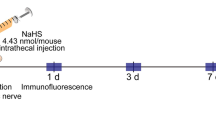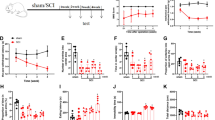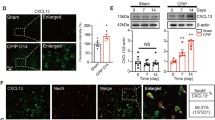Abstract
Studies showed a complex relationship between hydrogen sulfide (H2S) and neuropathic pain. In this study, the relationship between endogenous CBS–H2S pathway in L4–6 spinal cord and neuropathic pain was explored. A total of 163 adult Kunming mice were used in this study. CBS expression and H2S formation in L4–6 spinal cord were detected in the development of neuropathic pain firstly. Then, effect of AOAA, an CBS inhibitor, on treatment of neuropathic pain by chronic construction injury surgery (CCI) was detected. Pain thresholds and activation of NF-κB(p65), ERK1/2 and CREB were measured as biomarks of neuropathic pain. Results showed that CCI surgery significantly upregulated protein expression of CBS and H2S formation. Correlation analysis showed pain thresholds had negative relationships with protein expression of CBS and H2S formation. Treatment with AOAA, a CBS inhibitor, inhibited CCI-induced upregulation of CBS expression and H2S formation (P < 0.05). Further, AOAA significantly decreased activation of NF-κB(p65), ERK1/2 and CREB pathway, and reversed CCI-induced allodynia (P < 0.05). This indicated that CBS–H2S pathway promoted the development of neuropathic pain. CBS–H2S pathway could be a promising target for treatment of neuropathic pain.







Similar content being viewed by others
References
Kim HK, Park SK, Zhou JL, Taglialatela G, Chung K, Coggeshall RE, Chung JM (2004) Reactive oxygen species (ROS) play an important role in a rat model of neuropathic pain. Pain 111(1):116–124
Schäfers M, Sommer C (2007) Anticytokine therapy in neuropathic pain management. Expert Rev Neurother 7(11):1613–1627
Flatters SJ, Bennett GJ (2006) Studies of peripheral sensory nerves in paclitaxel-induced painful peripheral neuropathy: evidence for mitochondrial dysfunction. Pain 122(3):245–257
Takahashi T, Aoki Y, Okubo K, Maeda Y, Sekiguchi F, Mitani K, Nishikawa H, Kawabata A (2010) Upregulation of Ca v 3.2 T-type calcium channels targeted by endogenous hydrogen sulfide contributes to maintenance of neuropathic pain. Pain 150(1):183–191
Kimura Y, Mikami Y, Osumi K, Tsugane M, Oka JI, Kimura H (2013) Polysulfides are possible H2S-derived signaling molecules in rat brain. FASEB J 27(6):2451–2457
Nassini R, Materazzi S, Benemei S, Geppetti P (2014) The TRPA1 channel in inflammatory and neuropathic pain and migraine. Rev Physiol Biochem Pharmacol 167:1–43
Velasco-Xolalpa ME, Barragán-Iglesias P, Roa-Coria JE, Godínez-Chaparro B, Flores-Murrieta FJ, Torres-López JE, Araiza-Saldaña CI, Navarrete A, Rocha-González HI (2013) Role of hydrogen sulfide in the pain processing of non-diabetic and diabetic rats. Neuroscience 250:786–797
Kida K, Marutani E, Nguyen RK, Ichinose F (2015) Inhaled hydrogen sulfide prevents neuropathic pain after peripheral nerve injury in mice. Nitric Oxide 46:87–92
Lin JQ, Luo HQ, Lin CZ, Chen JZ, Lin XZ (2014) Sodium hydrosulfide relieves neuropathic pain in chronic constriction injured rats. Evid Based Complement Alternat Med 2014:514898
Li L, Xie R, Hu S, Wang Y, Yu T, Xiao Y, Jiang X, Gu J, Hu CY, Xu GY (2012) Upregulation of cystathionine beta-synthetase expression by nuclear factor-kappa B activation contributes to visceral hypersensitivity in adult rats with neonatal maternal deprivation. Mol Pain 8:89
Shao H, Xue Q, Zhang F, Luo Y, Zhu H, Zhang X, Zhang H, Ding W, Yu B (2014) Spinal SIRT1 activation attenuates neuropathic pain in mice. PLoS One 9(6):e100938
Zhi L, Ang AD, Zhang H, Moore PK, Bhatia M (2007) Hydrogen sulfide induces the synthesis of proinflammatory cytokines in human monocyte cell line U937 via the ERK-NF-κB pathway. J Leukoc Biol 81(5):1322–1332
Elies J, Scragg JL, Huang S, Dallas ML, Huang D, MacDougall D, Boyle JP, Gamper N, Peers C (2014) Hydrogen sulfide inhibits Cav3. 2 T-type Ca2+ channels. FASEB J 28(12):5376–5387
Bourinet E, Alloui A, Monteil A, Barrère C, Couette B, Poirot O, Pages A, McRory J, Snutch TP, Eschalier A, Nargeot J (2005) Silencing of the Cav3. 2 T-type calcium channel gene in sensory neurons demonstrates its major role in nociception. EMBO J 24(2):315–324
Jagodic MM, Pathirathna S, Joksovic PM, Lee W, Nelson MT, Naik AK, Su P, Jevtovic-Todorovic V, Todorovic SM (2008) Upregulation of the T-type calcium current in small rat sensory neurons after chronic constrictive injury of the sciatic nerve. J Neurophysiol 99(6):3151–3156
Zhang H, Zhi L, Moochhala S, Moore PK, Bhatia M (2007) Hydrogen sulfide acts as an inflammatory mediator in cecal ligation and puncture-induced sepsis in mice by upregulating the production of cytokines and chemokines via NF-κB. Am J Physiol-Lung Cell Mol Physiol 292(4):L960–L971
Okubo K, Takahashi T, Sekiguchi F, Kanaoka D, Matsunami M, Ohkubo T, Yamazaki J, Fukushima N, Yoshida S, Kawabata A (2011) Inhibition of T-type calcium channels and hydrogen sulfide-forming enzyme reverses paclitaxel-evoked neuropathic hyperalgesia in rats. Neuroscience 188:148–156
Popiolek-Barczyk K, Makuch W, Rojewska E, Pilat D, Mika J (2014) Inhibition of intracellular signaling pathways NF-κB and MEK1/2 attenuates neuropathic pain development and enhances morphine analgesia. Pharmacol Rep 66(5):845–851
Sen N, Paul BD, Gadalla MM, Mustafa AK, Sen T, Xu R, Kim S, Snyder SH (2012) Hydrogen sulfide-linked sulfhydration of NF-κB mediates its antiapoptotic actions. Mol Cell 45(1):13–24
Zhao K, Ju Y, Li S, Altaany Z, Wang R, Yang G (2014) S-sulfhydration of MEK1 leads to PARP-1 activation and DNA damage repair. EMBO Rep 15(7):792–800
Shibuya N, Tanaka M, Yoshida M, Ogasawara Y, Togawa T, Ishii K, Kimura H (2009) 3-Mercaptopyruvate sulfurtransferase produces hydrogen sulfide and bound sulfane sulfur in the brain. Antioxid Redox Signal 11(4):703–714
Ji RR, Kohno T, Moore KA, Woolf CJ (2003) Central sensitization and LTP: do pain and memory share similar mechanisms? Trends Neurosci 26(12):696–705
Kimura H (2015) Physiological roles of hydrogen sulfide and polysulfides. Handb Exp Pharmacol 230:61–81
Terada Y, Kawabata A (2015) H2S and pain: a novel aspect for processing of somatic, visceral and neuropathic pain signals. Handb Exp Pharmacol 230:217–230
Spiers DE, Candas V (1984) Relationship of skin surface area to body mass in the immature rat: a reexamination. J Appl Physiol Respir Environ Exerc Physiol 56(1):240–243
Song XS, Cao JL, Xu YB, He JH, Zhang LC, Zeng YM (2005) Activation of ERK/CREB pathway in spinal cord contributes to chronic constrictive injury-induced neuropathic pain in rats. Acta Pharmacol Sin 26(7):789–798
Donatti AF, Araujo RM, Soriano RN, Azevedo LU, Leite-Panissi CA, Branco LG (2014) Role of hydrogen sulfide in the formalin-induced orofacial pain in rats. Eur J Pharmacol 738:49–56
Sekiguchi F, Miyamoto Y, Kanaoka D, Ide H, Yoshida S, Ohkubo T, Kawabata A (2014) Endogenous and exogenous hydrogen sulfide facilitates T-type calcium channel currents in Cav3.2-expressing HEK293 cells. Biochem Biophys Res Commun 445(1):225–229
Acknowledgments
This work was funded privately.
Author information
Authors and Affiliations
Corresponding author
Ethics declarations
Conflict of interest
The authors declare no conflict of interest.
Rights and permissions
About this article
Cite this article
Gui, Y., Li, A., Qiu, B. et al. Endogenous CBS–H2S Pathway Contributes to the Development of CCI-Induced Neuropathic Pain. Neurochem Res 41, 1381–1389 (2016). https://doi.org/10.1007/s11064-016-1842-z
Received:
Revised:
Accepted:
Published:
Issue Date:
DOI: https://doi.org/10.1007/s11064-016-1842-z




